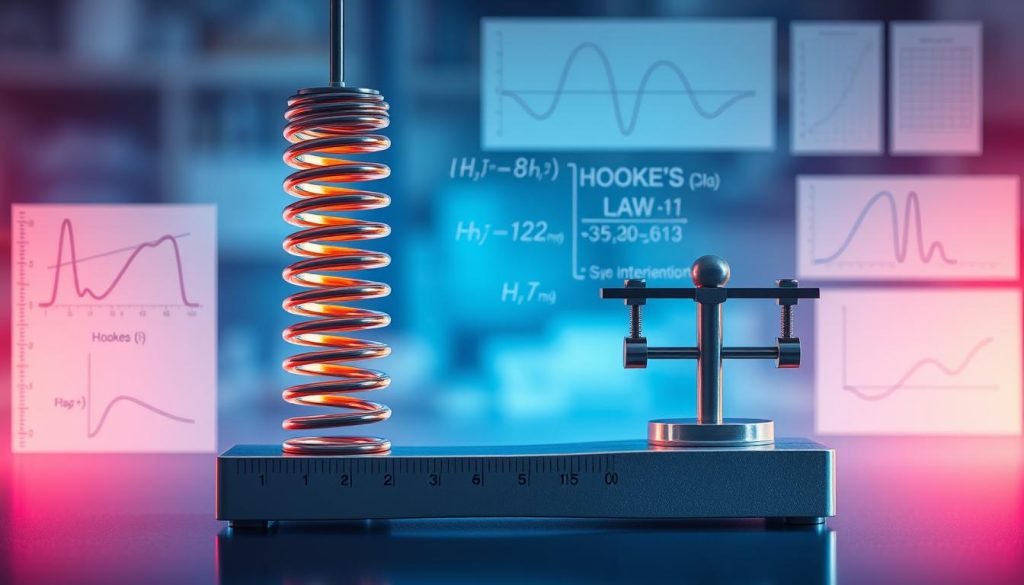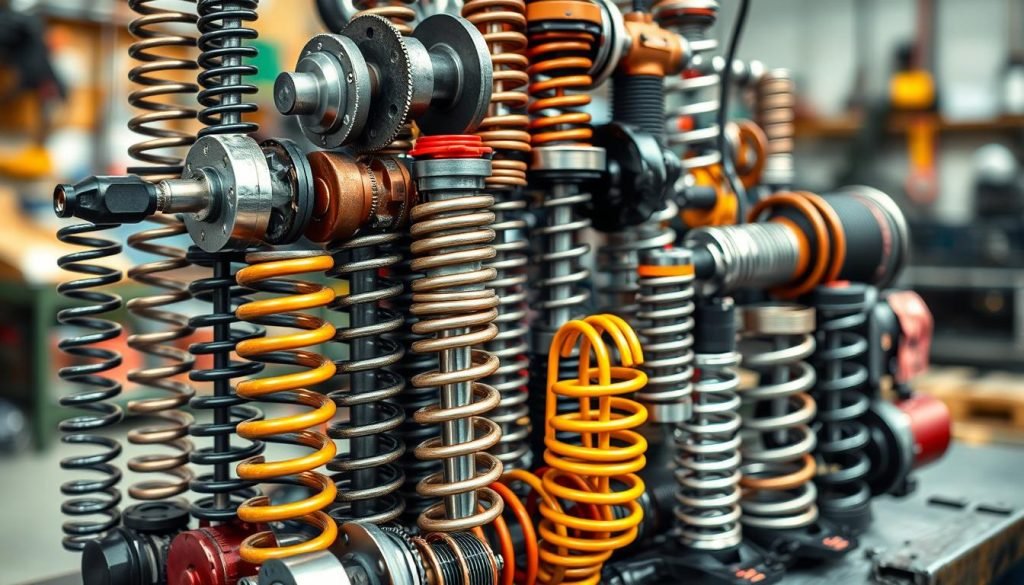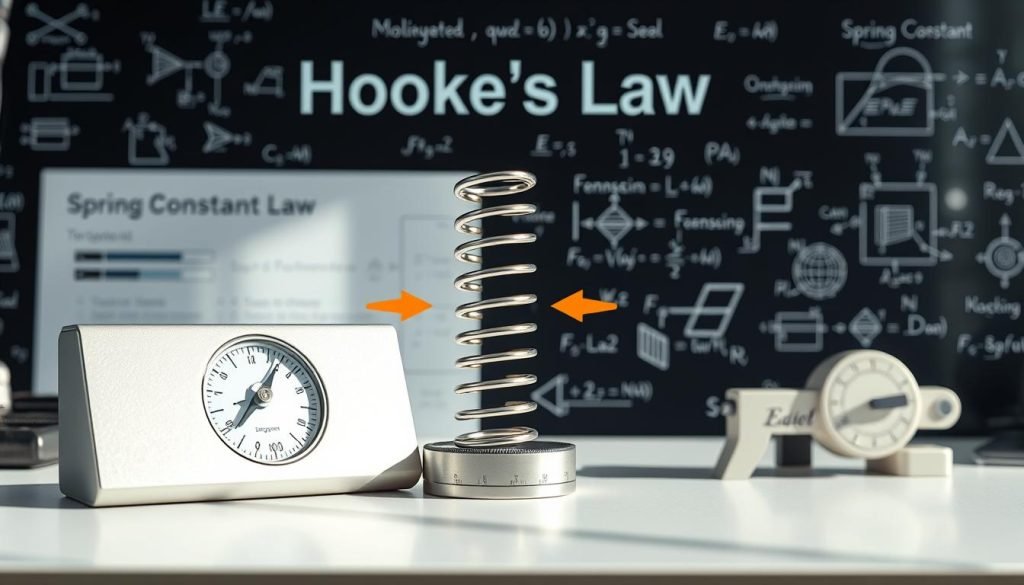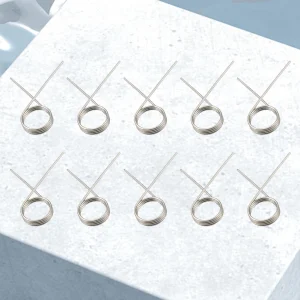Welcome to our guide on the spring constant. Here, you’ll learn how to find and calculate it. The spring constant is key in physics, helping us understand springs and elastic objects.
We’ll show you how to calculate the spring constant step by step. This guide is for students, researchers, and anyone interested in physics. It’s your resource for learning about the spring constant and its role in physics.
By the end of this guide, you’ll know how to find and calculate the spring constant accurately. Let’s explore the world of spring constants. We’ll see how it’s used in engineering, manufacturing, and more.
Understanding the Spring Constant: Basic Concepts
To understand the spring constant, we must first know the basic rules it follows. Hooke’s Law is key here. It says that the force needed to stretch or compress a spring is directly related to how far it’s stretched or compressed. This law is very important in physics, mainly when we’re measuring the spring constant.
In physics experiments, Hooke’s Law helps us understand springs and elastic objects. The spring constant shows how stiff a spring is. It’s measured in Newtons per meter (N/m). Knowing this is vital in many physics experiments, like measuring the spring constant.
- Understanding the relationship between force and displacement
- Recognizing the importance of units and measurements
- Applying Hooke’s Law in physics experiments
By understanding these points, we can better see how spring constants work in physics. This helps us build a strong base for learning more about physics experiments, including measuring spring constant and Hooke’s Law.
| Concept | Description |
|---|---|
| Hooke’s Law | States that the force needed to extend or compress a spring is proportional to the distance |
| Spring Constant | A measure of the stiffness of a spring, typically measured in Newtons per meter (N/m) |
| Units and Measurements | Understanding the units and measurements used when working with spring constants, including Newtons per meter (N/m) |
Essential Equipment for Spring Constant Measurements
To measure the spring constant accurately, you need the right tools. You’ll need springs with different constants, a ruler or meter stick, and weights or masses. A stopwatch might also be useful for timing. Knowing the spring constant formula helps pick the right equipment.
When setting up, making sure your measurements are accurate is key. This means calibrating your equipment and reducing outside influences on your results. Here are some important points to keep in mind:
- Choose springs with known constants to simplify calculations
- Use a ruler or meter stick with clear markings for precise distance measurements
- Select weights or masses that are easy to handle and provide consistent force application
Understanding the spring constant formula is essential for a successful experiment. With the right tools and careful measurement, you can get reliable and accurate results.
Remember, your goal is to measure the spring constant using the spring constant formula and physics equipment. Try to minimize errors and make your data as reliable as possible.
| Equipment | Description |
|---|---|
| Spring | Provides a known constant for measurement |
| Ruler or Meter Stick | Used for measuring distances and calculating the spring constant |
| Weights or Masses | Applies force to the spring for measurement |
How to Find the Spring Constant: Step-by-Step Method
To find the spring constant, you need to do a simple physics experiment. First, attach a spring to a fixed point. Then, add weights or masses to the spring’s end. This is key to measuring the spring’s extension or compression.
Accuracy is very important in physics experiments. Use a ruler or meter stick to measure the spring’s length with and without weights. Keep your data in a table or spreadsheet for easy access. The spring constant depends on how accurately you measure the spring’s change in length.
Setting Up Your Experiment
Choose a good spring and some weights or masses. Attach the spring to a fixed point, like a hook or clamp. Make sure it’s secure. Then, add weights one by one and measure the spring’s change in length.

Taking Accurate Measurements
When measuring, write down the weight or mass and the spring’s change in length. Use the same unit for all measurements, like grams or kilograms. This data will help you calculate the spring constant.
By following these steps and using your data, you can calculate the spring constant. This is a critical part of physics experiments. It ensures your results are accurate and reliable.
Common Sources of Error in Spring Constant Calculations
When measuring spring constant, it’s key to watch out for errors. Wrong measurements of the spring’s stretch or squeeze can mess up your results. Also, using the wrong spring constant formula or ignoring outside factors can make your calculations wrong.
To avoid mistakes, make sure your measurements are exact. Also, use the right spring constant formula. Here are some common errors to look out for:
- Inaccurate measurement of the spring’s extension or compression
- Incorrect application of the spring constant formula
- Failure to consider external factors that affect the spring’s behavior
Knowing these errors can help you fix them. This is very important in science, where being precise is critical.
Double-check your measurements and use the right spring constant formula. This will make your results more reliable. Paying close attention to detail is vital when measuring spring constant. It greatly improves the accuracy of your findings.
Applications of Spring Constants in Real Life
Spring constants are key in many fields, showing how physics matters in our world. They help in making new products and systems better. From cars to everyday items, spring constants ensure safety, comfort, and efficiency.
In the car world, spring constants are vital for suspension systems. Automotive suspension systems use them to smooth out bumps. Getting spring constants right is key for safe, comfy cars. They also help in making sure products are just right in manufacturing and quality checks.
Key Applications of Spring Constants
- Automotive suspension systems
- Manufacturing and quality control
- Consumer products, such as mattresses and exercise equipment
Spring constants are used in many ways in our lives. Knowing physics helps us solve common problems.
| Application | Importance of Spring Constants |
|---|---|
| Automotive Suspension Systems | Ensuring safety and comfort |
| Manufacturing and Quality Control | Ensuring precise measurements and high-quality products |
| Consumer Products | Providing comfort and efficiency |
In summary, spring constants are very important in our lives. They show how physics helps us every day. By using spring constants, we can make our lives better and solve problems.
Advanced Techniques for Complex Spring Systems
Dealing with complex spring systems requires a deep understanding of advanced physics. Springs can be set up in series or parallel, changing the system’s spring constant. To figure out the spring constant, you need to know the individual spring constants and how they’re arranged.
Calculating the spring constant for series and parallel springs is key. For series, you take the reciprocal of the sum of the reciprocals of each spring constant. Parallel springs have an equivalent spring constant that’s the sum of their individual constants.

- Understanding how spring setup affects the overall spring constant
- Using advanced physics to find the equivalent spring constant
- How individual spring constants influence the system’s behavior
Learning these advanced techniques helps you grasp complex spring systems. It lets you apply your knowledge in real-world situations and deepen your understanding of advanced physics.
Troubleshooting Spring Constant Measurements
When we do physics experiments, it’s key to fix spring constant issues. Problems can come from equipment, math mistakes, or the environment. Finding and fixing these problems helps us get good data.
In physics tests, equipment issues can mess up spring constant readings. Bad springs or tools can give wrong answers. So, we need to check and fix our gear often to keep it working right.
Common Troubleshooting Steps
- Check for loose connections or damaged wires
- Verify that measuring instruments are calibrated correctly
- Ensure that springs are properly secured and aligned
Also, calculation errors can happen when we use the spring constant formula wrong or don’t understand the data. To avoid these, we should always check our math and make sure our data is right. By doing this, we can get accurate spring constant readings and solid results in our physics tests.
Digital Tools and Software for Spring Constant Analysis
Digital tools have made analyzing spring constants easier. They help calculate and show spring constants more accurately and quickly. Using these tools can also reduce mistakes and make analysis better.
Choosing the right digital tool for spring constant analysis is important. There are many options, like software for spring constant analysis. This software helps users understand springs better and how they react to forces.
Recommended Applications
Here are some top picks for spring constant analysis:
- Online calculators for quick spring constant calculations
- Software for simulating spring behavior
- Digital tools for analyzing spring constant data
Online Calculators
Online calculators are handy for fast spring constant calculations. They work for various spring types and setups. You can find calculators for compression, extension, and torsion springs.
Digital tools, like spring constant software, help users understand spring behavior. This is great for engineers and designers working on spring-based products.
| Tool | Description |
|---|---|
| Spring Constant Calculator | An online calculator for quick spring constant calculations |
| Spring Simulator | A software for simulating spring behavior |
Conclusion: Mastering Spring Constant Calculations
Mastering spring constant calculations is a key skill in physics and engineering. You now know how to find the spring constant of different objects. This is thanks to Hooke’s Law and the step-by-step methods we’ve covered.
If you’re a student or a professional, knowing how to measure spring constants is vital. By using these mastering spring constant techniques, you’ll better understand physical phenomena. You’ll also improve your creations and help advance physics education.
Learning is a continuous journey. Keep experimenting and learning more about spring constants. The knowledge you’ve gained will help you in your future studies in physics.






